On April 12, Christina Mild led a small group of Ramsey Park’s Ebony Loop Thursday morning volunteers along narrow, man-made trails through Old Growth Arroyo Brush in the acreage belonging to McAllen’s Dr. Glatz.

This tour is not an exclusive opportunity for a select few. Fellow Texas Master Naturalist chapter member Dr. Glatz has extended an invitation for groups that would like to visit this Old Growth Arroyo Brush on his land near Rio Hondo.
“Everywhere you look, there are at least six species intermingling,” Chris remarked.
Indeed. If you’ve never seen a thicket, the word itself describes the land in an onomatopoeia way.
Were it not for man-made trails, one would have to swim/shove themselves through to inspect leaves or corollas with a magnifying glass, as Volker does upon occasion, or feel the leaves of plants and smell the foliage as Chris always encourages us to do — all important clues to learning plant identification.
The first plant Chris called our attention to was lantana. Not a lantana most of us are familiar with as this one grows only among the Arroyo Brush: Hammock lantana, Lantana canescens. It blooms all seasons having white corollas with yellow centers. Page 416, Dr. Al Richardson and Ken King book, Plants of Deep South Texas (PDST).
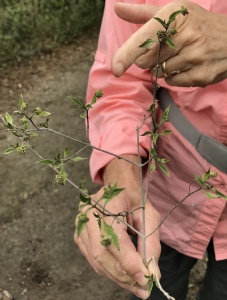
Here’s where it might be important to recognize by smell. The hammock lantana foliage smells differently than the more familiar pungency of Lantanas camara, urticoides and velutina.
Deeper along the trail brought a number of exclamations from Chris. It was a veritable smorgasbord and she couldn’t wait to describe plants that are not in our normal rounds when we maintain Ramsey’s Ebony Loop specialty gardens.
Manfreda, Manfreda variegata, is one particularly notable species special to this field trip. A plant in the lily family; check out page 19 PDST where it is listed as mottled tuberose or liverspot lily.
The first sighting was nearly hidden in the growth and detritus of the understory near the path. Eagle-eyed Chris had been looking for it. The sightings became more prevalent and the plants larger as we neared the river. I need not say it has an unusual bloom pattern which is depicted in the photo with Barbara’s hand.
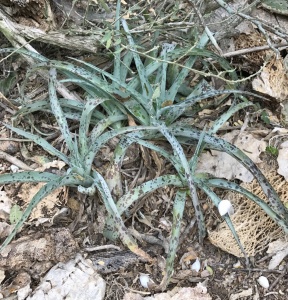
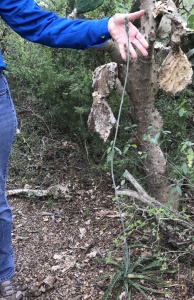
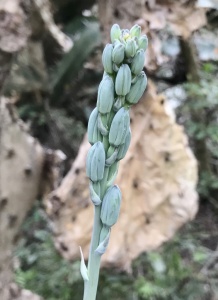
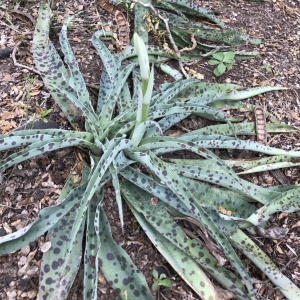
Let me backtrack — no pun intended. A few years ago, Harlingen Native Nurseryman and long-time UTPA instructor Mike Heep presented a fascinating, well-researched paper to the Native Plant Project (NPP) about the Arroyo Brush.
Chris, editor of the NPP monthly newsletter, will be republishing Mike’s paper in the April NPP newsletter, The Sabal, and will have it available on the NPP Website: www.nativeplantproject.com
Here is an excerpt from Mike’s paper:
(The descriptions are based on reconnaissance of 42 sites, during a period of about 20 years, of un-cleared brush along the Arroyo Colorado from southwest of La Feria to near where it drains into the Laguna Madre.)
“The brush along the Arroyo Colorado is distinct from the other woodlands in the Lower Rio Grande Valley. Although most of the common woody species in the LRGV occur in all recognized types of woodlands, the presence of particular species in the Arroyo brush give it a visibly distinct character.
“Most of the Arroyo Colorado brush is a very dense mixed growth dominated by small-leafed thorny shrubs and small trees. Most of the brush would be impassable but for man-made trails that have been cut through.
“There is a recognizable continuum in the height and density of the brush. On much of the higher, drier land the brush is from 3 to 8 feet in height and is readily passable. In and near the drainage ways the brush is high, from 8 to 20 feet and much denser.
“The dominant species at almost all sites are Ebony, Pithecellobium ebano, Coma, Bumelia celastrina, and Adelia, Adelia vaseyi.
“Abundant species in the Arroyo Brush include Amargosa, blackbrush, cenizo, Colima, coyotillo, crucillo, elbowbush, granjeno, guayacan, huisachillo, lotebush, snake eyes, prickly pear and Texas persimmon.”
The abundance of Adelia (PDST page 207) is probably the most unique aspect of the Arroyo brush, Mike notes in his paper. We noticed the limbs of the naturally-occurring shrubs were quite large, nearly two inches in diameter. By contrast, Adelia which has been planted in most nature preserves and butterfly gardens is probably less than 20 years old and is significantly smaller in all respects.
The bark on the older, naturally-occurring specimens curls and sheds.
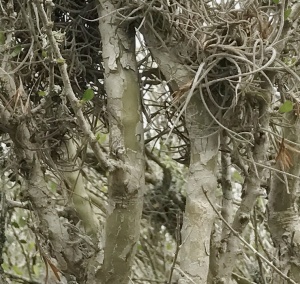
Lovers of ball moss and Bailey’s ball moss would be agog. PDST pager 28. Generally found in Ebony trees, they are not as discretionary in the Arroyo Brush, populating in many different trees such as this large Adelia close to the trail.
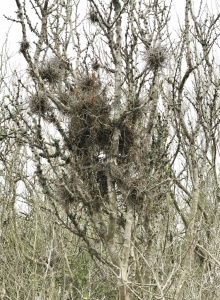
Also thrilling was the number of guayacán, Guaiacum angustifolium. PDST page 425. It’s one of those trees we consider rare-ish, having only five around the entire Ebony Loop in Harlingen’s Hugh Ramsey Nature Park.
If you aren’t familiar with the really awesome, slow-growing guayacán, it has delicate lavender and yellow blooms that turn into unique, heart-shaped seed pods that pop open in the winter to reveal one bright red fruit nearly the size of a pinto bean. In the Arroyo Brush, guayacán is everywhere ranging from one to eight feet tall, the tiny, feathery dark green leaves easy to spot.
Coma, Sideroxylon celastrinum, PDST page 382, reaching to 30 feet tall, were abundant as mentioned in Mike’s paper. Coma form their own groupings from root sprouts. A group of coma is a comal. Coma blooms fragrant clusters from the leaf axils then form black drupes. But beware, there are long slender thorns on the side branches.
If you’ve been told an easy way to identify coma is by the center leaf vein being curved like a punctuation comma, and have never quite seen that, search the tree (carefully — remember those long thorns) for larger, more mature leaves. Chris found one with a noticeable comma shape.
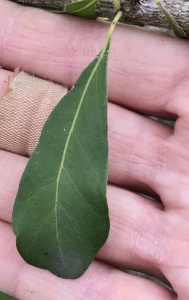
Other good clues to identify coma are that the leaves feel leathery, and the mature leaves snap a clean break when folded.
The pièce de résistance for me was near the end of the intertwining trails where we ended our two-hour stroll. Madeira vine or Sacasile, Anredera leptostachys, in the flesh, so to speak, their red twining stems hard to miss. PDST page 139.
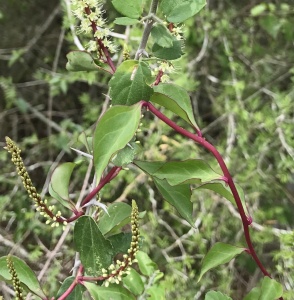

Small groups work best for this field trip as the trails are narrow. Tours are by appointment and it’s BYOG — in other words, bring your own guide.
Dr. Glatz also is looking for expert volunteer help, especially for species identification and annotating the signs he intends to use. Dr. Glatz may be contacted at 956-249-9433.
